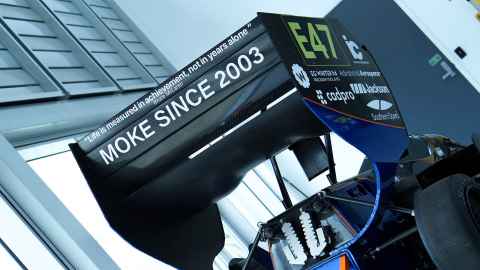My Space: Macgregor Jones
3 November 2025
The CEO of the University of Auckland FSAE team talks about life in the team's workshop.

Lighter, faster and stronger, the University of Auckland Formula SAE Team’s racecar is now on its way to Melbourne for the FSAE-Australasia competition, which runs from 11-14 December.
The Society of Automotive Engineers competition involves student teams designing, building, managing and racing their own car. Over the four days, teams are judged on everything from their design and engineering knowledge, to the cost of their car and its performance on the racetrack.
In Auckland’s case, 68 team members – mainly engineering students, but also from business and computer science – have collectively put in more than 50,000 hours to produce what team CEO and fourth-year mechatronics student Macgregor Jones reckons could be their best car yet.
The University’s team won the 2022 competition, was a leading contender in 2023 until its car suffered a catastrophic failure, and came second last year.
Macgregor says there are a few factors that give the team an edge: its purpose-built workshop, named after motorsport icons Sir Colin Giltrap and Bruce McLaren, is without peer among global SAE teams, and the team also has strong wider University support and a culture of nurturing student talent, he says.
Then there’s ‘moke’.
“Basically, years ago someone quickly mocked up a dashboard, and ‘mock’ was misspelt as ‘moke’,” he explains. “It stuck, and now it’s an everyday term we use that means something you quickly cobble together to get something done. As much as possible we’re aiming for high-level engineering, but ‘moke’ also embodies that number-eight wire mentality of just making something that works.”
Here Macgregor talks about his involvement with the team, and life in the Newmarket Campus-based workshop.

How long have you been involved in FSAE?
I joined in my first year at uni and this is now my fourth year. We’re lucky, and little bit different, because a lot of teams around the world will only take third- or fourth-year students, or they’ll do it as a masters project. We have a philosophy that if people join early, by the time they get to their fourth year, they’re going to be insanely knowledgeable and experienced, and they’ll also be able to pass that on to upskill others.
What do you enjoy about being involved?
When we won in 2022, that was great, but it’s the smaller things that stand out to me, like the first time the car runs. It’s literally just crawling around the car park, but it shows the accumulation of all your work. We expect a minimum of 15 hours a week per team member, but a lot of members will be doing many times that on top of their studies.
I’ve been quite heavily involved in the technical side of things; I spent three years in the electrical team, partly because that’s where my interest, knowledge and experience lie. One of our team’s values is to take ownership of our projects, so I get focused on keeping going with anything I’m working on, and I feel guilty if I stop.

What parts of the workshop are most familiar to you?
I’ve spent the most time over the years in the electronics room, especially when we’ve been locked in trying to find some gremlin that’s hiding in the car.
The workshop, more generally, is always a place where you get work done. You can design something at home, but your productivity is a whole lot higher here because you collaborate with others.
A lot of us in the team have gone through university together, so we help each other out here and with our study.
How will this year’s car go in competition?
Our number-one goal all year has been to win and I think we have as good a chance as any team. This car is going to be faster than any we’ve had before, so it will come down to our racing strategies and decisions.
Fortunately, some of the fundamentals of the car are relatively transferable from previous years, so we had a good baseline to start with, but we’ve made some good iterations. We’ve reduced the car’s mass by about 15 percent, mainly through the battery.
There’s always that question: will it survive? You can’t get rid of that no matter how much testing you do and, ironically, more testing can lead to more failures. But we have an incredible team going over to the competition, and hopefully we can get it dialled in.
Caitlin Sykes
This article first appeared in the November 2025 issue of UniNews.